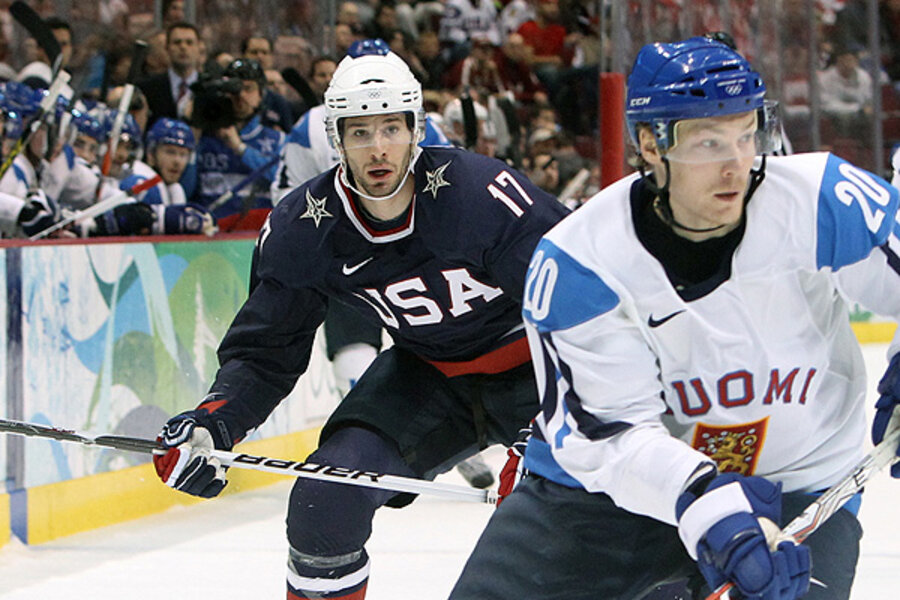USA vs. Canada: the triumph of black-and-blue hockey
Loading...
| Vancouver, British Columbia
Today's USA vs. Canada men's hockey game for the gold medal at the Vancouver Olympics is happening for one reason, says Brian Burke, the architect and general manager of team USA.
They both “play black-and-blue hockey,” he said Saturday, referring to North America’s traditionally more physical style.
In these Olympics, though, black-and-blue hockey has not meant just a desire to rattle the boards with body checks. It has meant a total commitment to team hockey.
That commitment is not always common among professional hockey players on their two-week Olympic break. Invariably, they are their nation’s best. But often they are also hockey’s divas – the goalscorers and creative geniuses who twirl into open ice with the grace of an autumn leaf or blast pucks on net like an artillery sergeant.
Yeoman they are not. The dirty work of penalty killing and blocking shots is for lesser players than they.
Yet every Olympics, and this one is no different, the hockey world is reminded of the indispensability of the men who seek their glory not in individual adulation or statistical flattery, but in their team's victories.
Team Canada: total commitment
Canada is the most talented team in the tournament. Yet before its home crowd, each athlete has been a warrior, doing the tasks that won’t make a Top 10 montage, but make life miserable for opponents.
After the comprehensive 7-3 quarterfinal victory against Russia, forward Rick Nash, one of the National Hockey League’s best players, said: “We wanted to play in their end as much as possible.”
The inference there was not to scoring goals, but to prevent Russia from scoring goals. In other words, simply by working the puck in the corners and keeping the puck in the Russian zone – regardless of goals – Canada would prevent the Russians from scoring.
The Canadians were, in essence, playing defense with their offense – committing to a yeoman game plan instead of individual glory.
The way the Russians played, it appeared as if there were no words in the Russian language to convey this idea. The Russians were more likely to use halibut instead of hockey sticks than use offense as a defensive weapon.
The offensive zone, you see, is for preening and playing postcard hockey. At least, that is what they will be thinking on the plane ride home.
“We grinded in the corners,” said forward Cory Perry. “These guys don’t want to play defense, they want to score goals.”
But guess who scored the goals? Canada.
Team USA: We were made for this
Team USA plays the same way, though for a different reason than national pride alone: It was built this way. Burke and his team did not pick America’s 23 most skilled hockey players. They picked the best player for every position they needed.
The result is that each player is perfectly suited for the role he has to play, whether it’s scoring goals or blocking shots. “We’re not asking 30-goal scorers to do grunt work,” he said in a press conference Saturday. “We have grunts to do the grunt work.”
Team captain Jamie Langenbrunner stressed this point after the 6-1 semifinal win over Finland: “You don’t have to score goals to do something positive for the team: block shots, make hits, don’t retaliate to a punch.”
All these seemingly lesser virtues were apparent in the game against Finland, where the team defense was, in many respects, even more impressive than the offense. Led by Zach Parise and Ryan Kesler, skilled forwards who embody the idea of defending from the front, the US resembled a swarm of bees as much as a hockey team.
Technically, the offense scored six goals in the first 13 minutes of the game, but that surge was borne on waves of unrelenting pressure all over the ice, forcing turnovers.
“We wanted to make sure we surprised them with our speed and our puck pursuit,” said USA coach Ron Wilson after the game.
These are hockey basics: don’t turn the puck over in the neutral zone, finish your checks, get traffic in front of the net – not the sort of thing that should be foreign to hockey’s best players. Yet in the Olympics, where most top teams come together the day before their first game, there’s not time to dwell on anything but the basics.
“You have to simplify everything,” said Wilson. “You don’t come in and dazzle them with 35 new drills.”
Among the tournament’s best teams, the US and Canada have been the best not only at sticking to the basics, but doing them with passion and complete commitment.
Turin turnaround
It is a complete reversal from four years ago, when the US and Canada took two aging, stale teams to Turin and were both deservedly gone by the quarterfinal round. The rink surely plays at least a part. North American hockey rinks are smaller then European rinks, putting a premium on the physical qualities that Burke prizes.
But neither the US nor Canada played with nearly so much heart as they have here – a reflection of how the teams were built and whose fans are here cheering.
Today, the roles from the Finland game will be reversed for the US. The US will hope to weather a Canadian storm of emotion at the start. “We’re going to have to survive the first five to 10 minutes, which Russia wasn’t ready to do,” said Wilson.
But for team USA, the recipe will be nothing new, Kesler said: “We’ve got to use our speed to try to hit them, to try to work them.”
Black-and-blue hockey for gold.
-----





